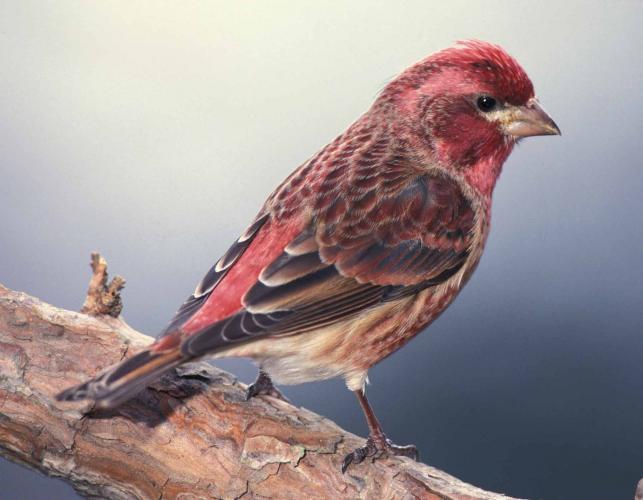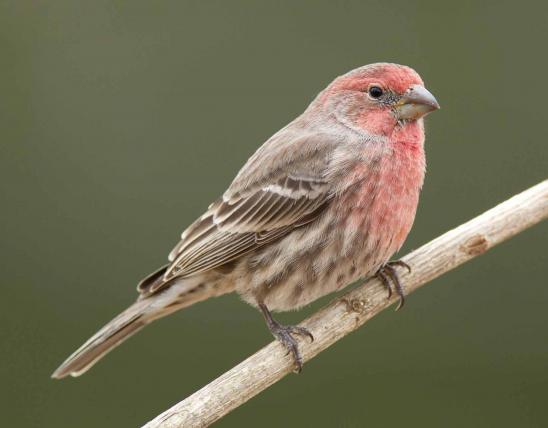
Upperparts of the male purple finch are raspberry red, with brown wings, tail, and streaks on back. The tail is strongly notched at the tip. Underparts are raspberry red, mixed with white, with little or no brown streaking on the breast and sides. The belly and under tail feathers are white. Female upperparts are heavily streaked with brown, with a broad whitish eyebrow and moustachial streak. Underparts are streaked brown, with a heavy dark streak along the side of the throat. Under tail feathers are white and unstreaked. The song is an energetic, bubbly warble. The call is a soft “pick.”
Similar species: The house finch is a common permanent resident, so in Missouri, if you see a reddish finch between May and September, it is probably a house finch. Male house finches usually lack any purplish cast, and both sexes lack a light eyebrow line and have a square or only slightly notched tail. The call is a rising, two-note “tooit.”
Length: 6 inches.

Statewide.
Habitat and Conservation
Common in cities and towns, around farms, and in suburban areas, foraging on the ground or in trees. It frequently attends bird feeders in large flocks. Unlike the house finch, with which it is often confused here in the eastern United States, the purple finch is native to our region. People see purple finches most commonly at birdfeeders in winter. Half a century ago, house finches were rarely, if ever, seen in Missouri; now it is a trick to tell them apart as they dine at feeders.
Food
Forages on the ground and in trees for insects, seeds, tree buds, fruits, and berries. Frequently attends bird feeders for sunflower and millet seeds. The conical bill typical of finches is adapted for cracking the seeds of sunflowers, grasses, and more. Animals that eat fruits, including seeds, are called “frugivores.”
Status
Common migrant; uncommon winter resident. Present in our state from October through April. This species seems to be declining in the eastern and northern parts of its range, and biologists think the decline may be caused by competition with the house finch, which was introduced to the eastern United States in 1940.
Life Cycle
Purple finches nest in cool evergreen forests in their breeding range in Canada, New England, and around the Great Lakes. They spend winters in much of the eastern United States. Therefore, unless you see one in a museum, you probably won’t see the nest of a purple finch in Missouri.
Human Connections
When people introduced the house finch to the eastern United States, that species competed strongly against its close relative the purple finch. Where the two come into direct contact and compete for food and nesting space, the house finch “wins” about 95 percent of the time.
Ecosystem Connections
Fruit-eating birds usually help to distribute the seeds of the berries and other fruits they eat and thus “repay” the plant for the food. But finches crack and digest the seeds as well as the fruit; therefore, they hinder the plant’s ability to reproduce.








About 350 species of birds are likely to be seen in Missouri, though nearly 400 have been recorded within our borders. Most people know a bird when they see one — it has feathers, wings, and a bill. Birds are warm-blooded, and most species can fly. Many migrate hundreds or thousands of miles. Birds lay hard-shelled eggs (often in a nest), and the parents care for the young. Many communicate with songs and calls.






















